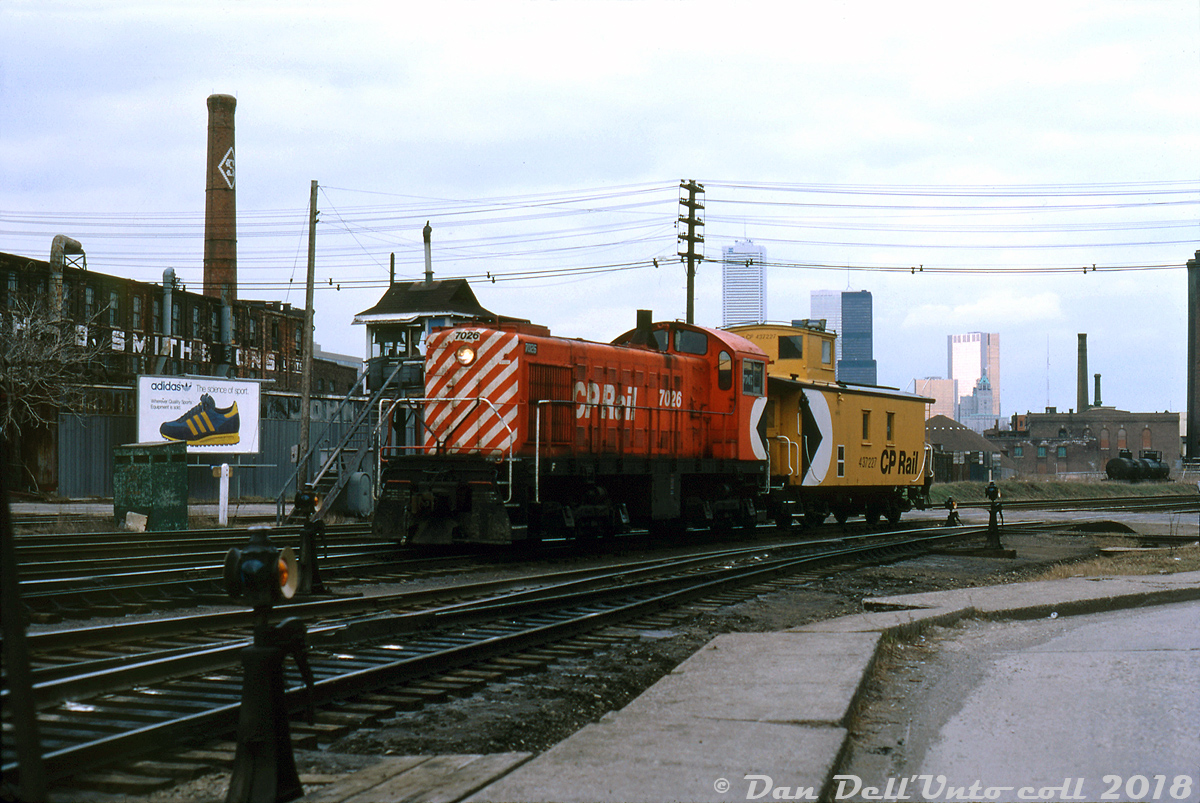|
Caption: Relics of the past: CP S2 7026 and van 437227 amble over Strachan Avenue grade crossing, passing the crossing tower as they head north into Parkdale Yard as light power. At the time a gateman manning the crossing tower still manually operated the Strachan Ave. gates and warning lights for the CN Weston Sub and CP Galt Sub that crossed here on their way to the Toronto Terminals Railway territory downtown (the green shack near the Adidas sneaker ad was apparently the gateman's loo). Coloured switch lanterns mounted on switchstands dot the south end of Parkdale Yard's tracks. Visible in the background are the old John B. Smith & Sons building on the left (a former lumber dealer), the city's Wellington Destructor (garbage incinerator) on the right, and two tank cars spotted on the siding for the Toronto Municipal Abbatoir / Quality Packers ("tank siding", off of CN's Weston Sub). Modern office towers in the distance (and CP's Royal York Hotel) contrast with the gritty blue-collar industrial environs of the Parkdale area.
One of many small switchers built by Alco (and later MLW) for CP, the little 1000hp 7026 dates back to 1945 when CP was still ordering brand new steam engines (for road service) alongside diesel yard switchers. By 1979, the motive power assignment sheets show 7026 was one of nearly 30 little S2, S3 and S4 switchers assigned and maintained out of John St. Roundhouse downtown for local and yard switching duties in the Toronto area out of CP's various yards (Parkdale, Lambton/West Toronto, etc).
CP was also still using ancient steam-era wooden vans in local and transfer service in the 1980's. 437227 is notable in that it still has its old tounge-and-groove siding (escaping the plywood treatment most wooden vans got) and has its multimarks applied on the cupola end, where typical CP practice saw it almost always applied on the non-cupola end of wooden vans.
In less than a decade, declining industrial manufacturing in the areas surrounding downtown Toronto would result in both Parkdale Yard and John St. Roundhouse closing, and with it the remaining steam-era Alco/MLW diesel switchers maintained there would retire (replaced by more modern rebuilt SW and GP units). The abolishment of vans on freights in the late 80's also caused the newer modern Angus-built steel vans that had been in mainline run-through service bump the older steel and wooden vans from local service into retirement. Today aside from a few remaining industrial buildings (John B. Smith and the Wellington Destructor) this area is almost unrecognizable as modern condos have arisen in Libery Village and King West Village on many of the former industrial lands, and the crossing at Strachan has been eliminated in favour of a giant grade separation ducking under the roadway.
Bill McArthur photo, Dan Dell'Unto collection slide.
For a view of the area shot from Strachan Avenue a few years prior to the grade separation, see: http://www.railpictures.ca/?attachment_id=15195.
|



Great shot! and I love the Adidas trainers on the billboard to boot!
Also Dan..Nice historical read thank you. I’m sure those little 1000hp S2 – S4′s put out more power than competitive GMD unit’s (SW 900′s, 1200′s even).
As I understand it, CP started off buying lots of 1000hp S2′s in the early days, and did sample some GMD SW8/900′s, but in the 1950′s found MLW’s 660hp S3 to be the perfect light switcher at the time (they didn’t need the 1000hp of the S2′s on many jobs, and the turbo was an extra maintenance expense), and switched to buying more of them over other units. As time went on however, they were found to be a little underpowered for the heavier trains and more demanding assignments. Probably why a lot of the older S2′s stuck around until the end, despite being 5-15 years older than the newer S3′s.